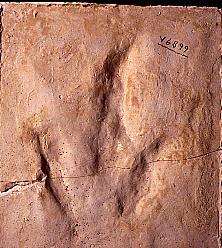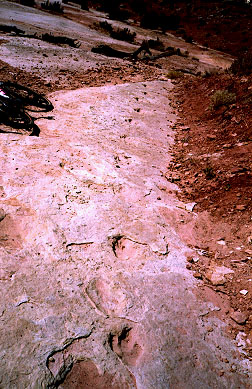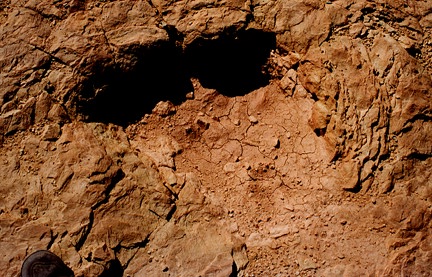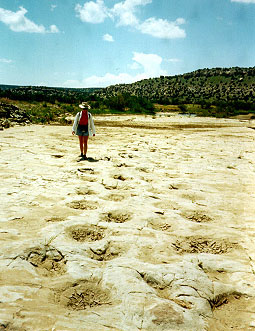
Theropod footprint

Theropod Trackway - Klondike Bluff, Utah
(Terry Acomb, 1996)

Sauropod footprint - Morrison Formation, Utah (A.J.Martin)

Sauropod Trackway - Southeast Colorado
(Terry Acomb, 1996)
When footprints of the same species follow in succession they
are known as trackways. Most dinosaurs had a gait which is known
as diagonal walking. Diagonal walking is recognized by an angle from
the center of movement to the foot prints formed. If you ever see
the footprints of a horse, they would be an example of a diagonal walking.

Theropod footprint |

Theropod Trackway - Klondike Bluff, Utah (Terry Acomb, 1996) |
These two photographs show tracks of a theropod. Distinct features being the three digits relatively close to each other and the prominent middle toe. Notice in the left photo how the track deepens as you come to the end of the toes. This indicates that theropods walked with a horizontal posture and that they didn't drag their tails. |

Sauropod footprint - Morrison Formation, Utah (A.J.Martin) |

Sauropod Trackway - Southeast Colorado (Terry Acomb, 1996) |
In the left photo you can tell it is a right foot by the way the mud is pushing up and to the right. In the right photo you can see the trackway of a couple of sauropods. |
Regarding the way they traveled, dinosaurs can be categorized into two major groups: bipedal, traveling on two hind legs, or quadrupedal, traveling on all four legs. These two categories can be subcategorized into two other groups regarding their preferred stance, obligate biped and obligate quadruped. An obligate biped which could also travel on all four limbs can also be known as a facultative quadruped. An obligate quadruped which can also travel on the two hind legs can also be known as a facultative biped. Bipedal tracks, found in the field, have a three-toed shape, common to theropods, and most of them were obligate bipeds. There are some rare findings of tracks which show them as facultative quadrupeds. Most bipedal tracks show the animal traveling in an unhurried fashion. The stance or gait shows that they walked quite straight, this indicating that they were most likely quite agile. Some rare findings show they could achieve speeds up to 45km/h. Obligate quadrupeds, the most common type of dinosaur, had the manus, the front foot, and the pes, the back foot. Their feet consisted of different combinations of toes from three toes to five toes. The number of toes on the pes and manus can be seen in the trace fossils and they agree with the body fossils. The quadrupeds displayed diagonal walking where the right manus and the left pes would move forward as the left manus and right pes moved backwards and vice versa. The quadrupeds also showed that they were slow moving, and there are no tracks showing them running.